1996 PONTIAC BONNEVILLE wheel size
[x] Cancel search: wheel sizePage 239 of 387
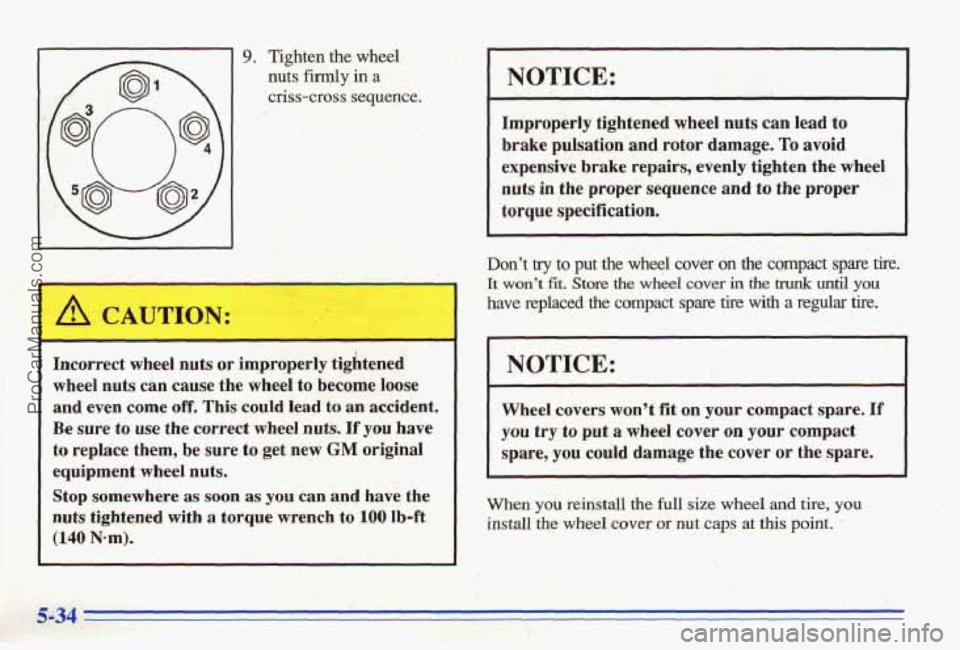
9. Tighten the wheel
nuts firqly in a ' ,
criss-cross sequence.
Incorrect wheel nuts or improperly tightened
wheel nuts
can cause the wheel to become loose
and even
come off. This could lead to am accident.
Be sure to use the correct wheel nuts. If you have
to replace them, be
sure to get new GM original
equipment
wheel nuts.
Stop somewhere as soon as you can and have the
nuts tightened with
a torque wrench to 100 b-ft
(140 N-m).
NOTICE:
Improperly tightened. wheel nuts can lead to
brake pulsation 'and .rotor damage. To avoid
expensive brake repairs, evenly tighten the wheel
nuts in the proper sequence and to the proper
torque specification.
Don't try to put the wheel cover on the compact spare tire.
It won't fit. Store the wheel Cover in the trunlr until you
have replaced the compact spare tire with a regular tire.
I NOTICE:
Wheel covers won't fit on your compact spare. If
you try to put.a wheel cover on your compact
spare, you could damage the cover or the spare.
When you reinstall the full size wheel and tire, you
install the wheel cover or nut caps at this point. '
ProCarManuals.com
Page 242 of 387
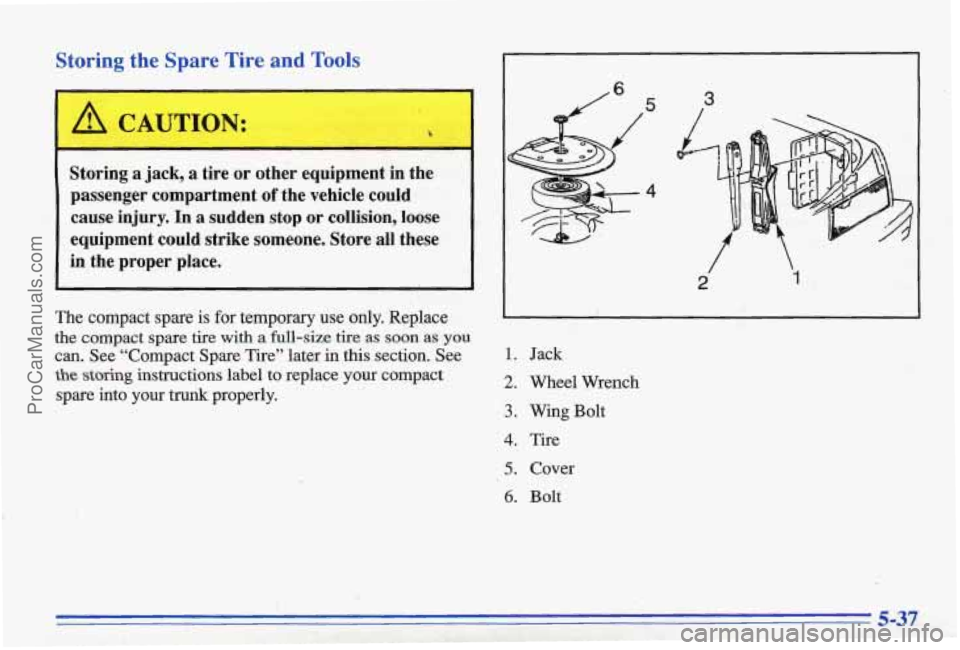
Storing the Spare Tire and Tools
Storing a jack, a tire or other equipment in the
passenger compartment
of the vehicle could
cause injury. In
a sudden stop or collision, loose
equipment could strike someone. Store all these
in the proper place.
The compact spare is for temporary use only. Replace
the compact
spare tire with a full-size tire as soon as you
can. See “Compact Spare Tire” later in this section. See
the storing instructions label to replace your compact
spare
into your trunk properly.
5 3
4
2‘ 1
1.
2.
3.
4.
5.
6.
Jack
Wheel Wrench
Wing Bolt Tire
Cover
Bolt
5-37
ProCarManuals.com
Page 243 of 387
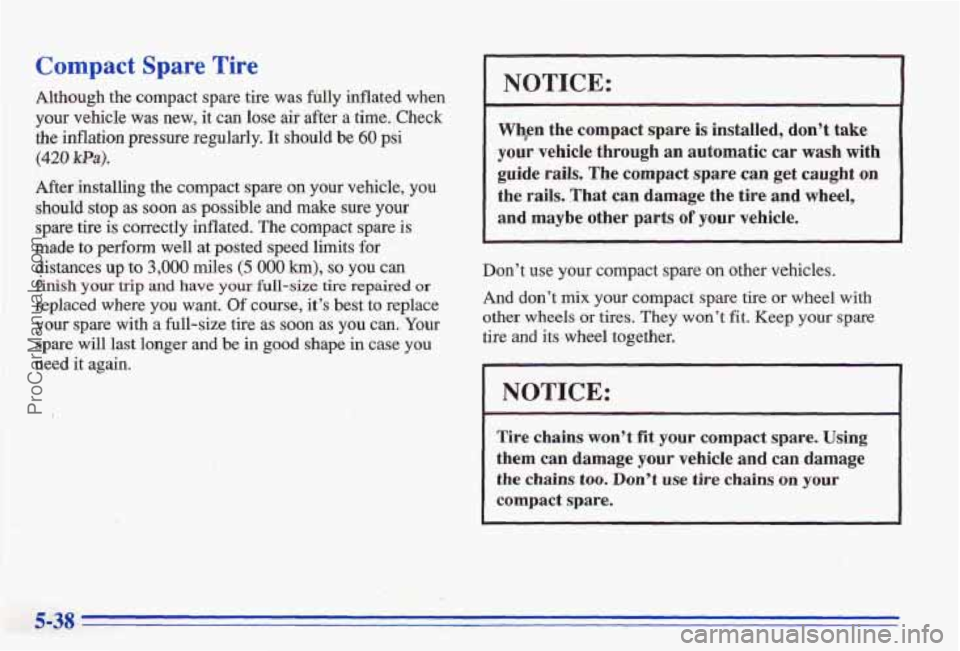
Compact Spare Tire
Although the compact spare tire was frilly inflated when
your vehicle was new, it can lose air after a time. Check
the inflation pressure regularly. It should be.60 psi
After installing the compact spare can your vehicle, you
should stop as soon as possible and make sure
your
spare tire is correctly inflated. The compact spare is
made to perfom well at posted speed
limits for
distances up
to 3,000 miles (5 000 km), so YOU can
f~sh your trip and have your full-size tire repaired or
replaced where you want. Of course, it’s best to replace
your spare with a full-size tire as soon as you can. Your
spare
will last longer and be in good shape in case you
need it again.
(420 Wa).
NOTICE:
Whpn the compact spare is installed, don’t take
your vehicle through an automatic car wash with
guide rails.
The compact spare can get caught on
the rails. That can damage the tire and wheel,
and maybe other parts
of your vehicle.
Don’t use your compact spare
on other vehicles.
And don’t
mix your compact spare tire or wheel with
other wheels or tires. They won’t fit. Keep your spare
tire and its wheel together.
NOTICE:
Tire chains won’t fit your compact spare. Using
them can damage your vehicle and can damage
the chains
too. Don’t use tire chains on your
compact spare.
ProCarManuals.com
Page 290 of 387
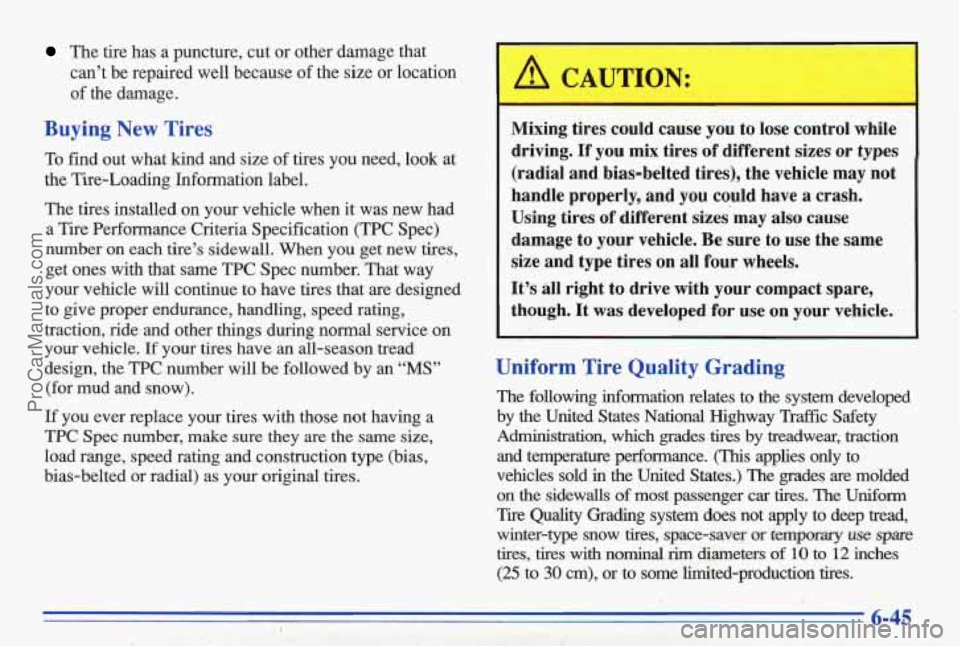
The tire has a puncture, cut or other damage that
can’t be repaired well because of the size or location
of the damage.
Buying New Tires
To find out what kind and size of tires you need, look at
the Tire-Loading Information label.
The tires installed on your vehicle when it was new had
a Tire Performance Criteria Specification (TPC Spec)
number on
each tire’s sidewall. When you get new tires,
get ones with that same TPC Spec number. That way
your vehicle will continue to have tires that are designed
to give proper endurance, handling, speed rating,
traction, ride and other things during normal service
on
your vehicle. If your tires have an all-season tread
design, the TPC number will be followed by an
“MS”
(for mud and snow).
If you ever replace your tires with those not having a
TPC Spec number, make sure they are the same size,
load range, speed rating and construction type (bias,
bias-belted or radial) as your original tires.
A CAUTION:
Mixing tires could cause you to lose control while
driving.
If you mix tires of different sizes or types
(radial and bias-belted tires), the vehicle may not
handle properly, and you could have a crash.
Using tires
of different sizes may also cause
damage to your vehicle. Be sure to use the same
size and type tires on
all four wheels.
It’s all right to drive with your compact spare,
though. It was developed
for use on your vehicle.
Uniform Tire Quality Grading
The following information relates to the system developed
by the United States National Highway Traffic Safety
Administration, which grades tires by treadwear, traction and temperature performance.
(Th.zs applies only to
vehicles sold in the United States.) The grades are molded
on the sidewalls of most passenger car tires. The Uniform
Tire Quality Grading system does not apply to deep tread, winter-type snow tires, space-saver
or temporary use spare
tires, tires with nominal rim diameters of 10 to 12 inches
(25 to 30 cm), or to some limited-production tires.
I 6-45
ProCarManuals.com
Page 293 of 387
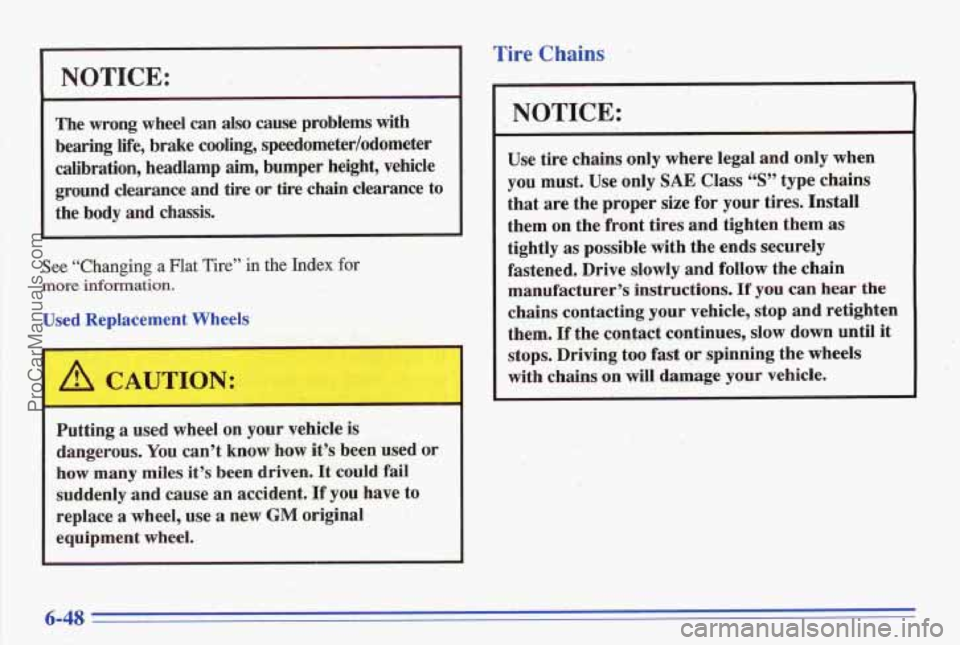
NOTICE:
The wrong wheel can also cause problems with
bearing life, brake cooling, speedometer/odometer
calibration, headlamp aim, bumper height, vehicle
ground clearance and tire or tire chain clearance to
the body and chassis.
.. -* ‘ .. ’ see “Changing a Flat Tire” in the Index for
‘more information.
.. .‘I, . .I .
.‘. -- . 8; . Putting a used wheel on your vehicle is
;. .. . dangerous. You can’t know how it’s been used or
,.; how many miles it’s been driven. It could fail
-. :% suddenly and cause an accident. If you have to
. -1 . .. I -.~ I., .<.
.. ?1 :: :. <.. >. - ., 3
I .) .
,,.. ‘,,‘t, . .?. I
.: replace a wheel, use a new GM original
.I , . ..
., , equipment wheel. -.
-. ., ..
I
Tire Chains
NOTICE:
Use tire chains only where legal and only when
you must. Use only
SAE Class 44S” type chains
that are the proper size for
your tires. Install
them on the front tires and tighten them as
tightly as possible with the ends securely
fastened. Drive slowly and follow the chain
manufacturer’s instructions.
If you can hear the
chains contacting
your vehicle, stop and retighten
them.
If the contact continues, slow down until it
stops. Driving too fast or spinning the wheels
with chains on will damage your vehicle.
* “
ProCarManuals.com
Page 304 of 387
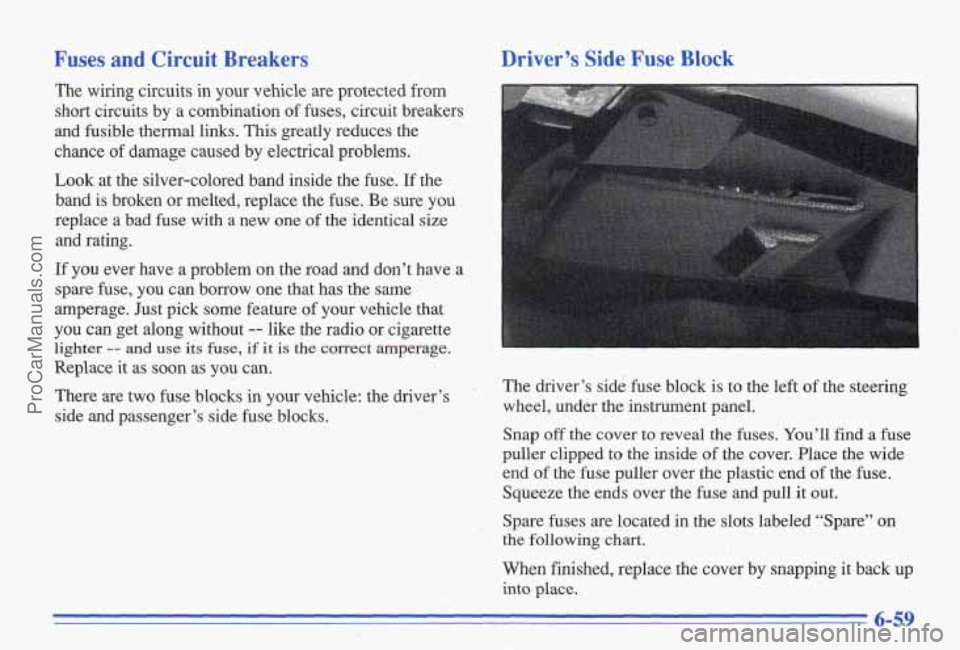
Fuses and Circuit Breakers
The wiring circuits in your vehicle are protected from
short circuits by a combination of fuses, circuit breakers
and fusible thermal links. This greatly reduces the
chance of damage caused by electrical problems.
Look at the silver-colored band inside the fuse. If the
band is broken
or melted, replace the fuse. Be sure you
replace a bad fuse with a new one
of the identical size
and rating.
If you ever have a problem on the road and don’t have a
spare fuse,
you can borrow one that has the same
amperage. Just pick some feature of
your vehicle that
you can get along without -- like the radio or cigarette
lighter -- and use its fuse, if it is the eomect amperage.
Replace it as soon as you can.
There are two fuse blocks in your vehicle: the driver’s
side and passenger’s side fuse blocks.
Driver’s Side Fuse Block
The driver’s side fuse block is to the left of the steering
wheel, under the instrument panel.
Snap off the cover to reveal the fuses. You’ll find a fuse
puller clipped to the inside of the cover. Place the wide
end of the fuse puller over the plastic end of the fuse.
Squeeze the ends over the fuse and pull it out.
Spare fuses are located in the slots labeled “Spare”
on
the following chart.
When finished, replace the cover by snapping it back
up
into place.
ProCarManuals.com